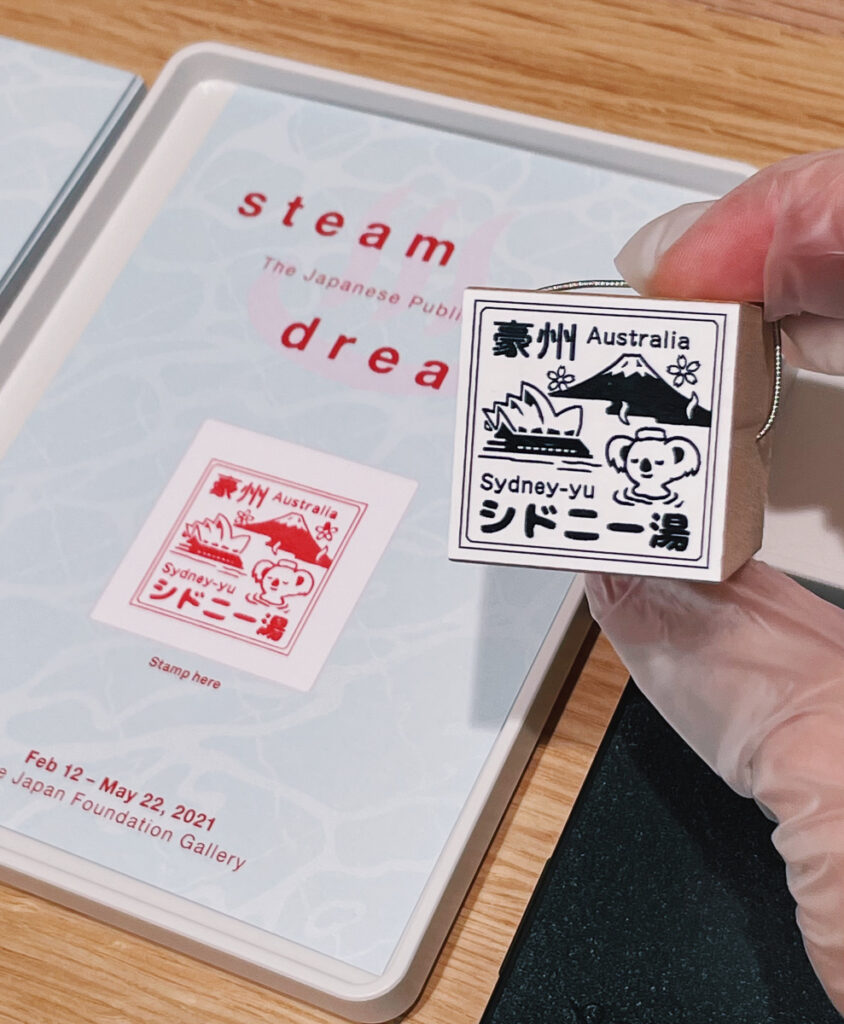
What’s the life of a stamp maker in Japan today? We ask Toshizō Hirose, who was commissioned to make a sentō stamp for an exhibition about Japanese bathhouses in Sydney.
1.廣瀬さんの人生について教えてください。どちらの出身ですか?またどのような幼少期を過ごしましたか?
神奈川県の横浜市で生まれ育ちました。当時の横浜はまだ田んぼや畑や森林が多く、いつも虫採り、ザリガニ釣りなどをしていました。落ち着きがない、とよく言われていました。7歳までは家に風呂が無く、銭湯に通っていました。
その後しばらくは銭湯から離れていましたが、結婚して移り住んだ地(東京都足立区千住)が銭湯の密集地帯で、地元のタウン誌を作るグループに入り、活動するうち銭湯熱のスイッチが入りました。
大学卒業後、プログラマーをしていましたが、2015年に銭湯ハンコ作家として独立しました。
✿ Can you give a brief life story?
I was born and raised in Yokohama, Kanagawa. There were still many rice paddies, fields and forests in Yokohama at that time, and I was always out doing things like collecting bugs and catching crayfish. I was often said to be a restless child. We didn’t have a bath in our home until I was seven, so we would go to the sentō (public bath).
I didn’t go to the sentō for a while after that until I married and moved to a place called Senju in Adachi, Tokyo, where there were many of them. I joined a group that produced a magazine about the town, which rekindled my enthusiasm for sentō.
After graduating from university, I worked as a programmer until 2015 when I established myself as an independent sentō stamp maker.
2.銭湯スタンプ作りにご興味を持つようなきっかけを教えてください。
ナンシー関(1962-2002)さんという版画家兼コラムニストのファンでした。消しゴムハンコというジャンルを作った方でした。2002年、若くして亡くなられ、2008年に回顧展に行った際、その消しゴムハンコの数と面白さに圧倒され、自分でもやってみたいと思いました。そのまま真似しても面白くないので、自分の好きな銭湯のご主人の似顔絵を彫りました。勝手に彫って勝手にプレゼントする、というのが楽しくてたくさん彫りました。
✿ How did you come to be interested in making sentō stamp?
I was a fan of printmaker and columnist Nancy Seki (1962-2002), who made eraser stamps. She died young, in 2002, and I remember going to a retrospective exhibition in 2008 and being overwhelmed by the sheer number of her eraser stamps and their comical nature. The experience made me want to try making them for myself. Rather than just copy them, which didn’t seem like much fun, I carved a portrait of the owner of my favourite sentō. I enjoyed making these carvings and randomly presenting them to people, and so I started to make more.
3.スタンプ作りをどのように習いましたか。先生などはいらっしゃいましたか。また、習得するのはどのぐらいかかりましたか?
まったくの自己流です。基本的なことはインターネットで学びました。今でも習得したとは思っていませんが、最初からそこそこ出来ました。すなわち誰でもやればそこそこ出来るやさしく楽しい趣味です。それを仕事のレベルまで上げるのは、技術よりもデザインだと思っています。ロゴデザイン集や漫画の教科書は勉強になりました。
✿ What is the process of learning to make these stamps?
I am completely self-taught and learned the basics online. I still think I have a lot to learn, but I had an aptitude for it from the beginning. In other words, it’s an easy, fun hobby that anyone can pick up. Design rather than technique is what elevates it from a hobby to a profession. Books on logo design and manga textbooks have helped me learn a lot.
4.シドニー湯のスタンプはどのようにデザインしましたか?
「日豪友好」をテーマにデザインしました。日本の富士山と桜、シドニーのオペラハウスとコアラは共に象徴的なモチーフです。入浴時に頭にタオルを乗せるのは日本の習慣です。シドニー湯は架空の銭湯ですが、もし存在していたらスタンプはこんな感じだろうし、これがきっかけになって、本当にシドニー湯が出来たら楽しいなと思いながら作りました。
✿ What was the process of designing the sentō stamp for Sydney?
I designed this stamp with the Australia-Japan friendship in mind. Japan’s Mount Fuji, the cherry blossom, Sydney Opera House and the koala are all symbolic motifs. It’s customary in Japan to place a towel on your head in the bath. The Sydney baths are fictitious, of course, but if one existed, I imagined its stamp would look something like this. As I was making it, I thought how delightful it would be if this stamp became the impetus to build a sentō in Sydney!

5.このようなスタンプは日本でどのように使われていますか?コレクターが集めるのでしょうか?一般の人も興味を持っていますか?
印鑑が日本ではサインの代わりをしてきたという歴史が長いため、スタンプは日本ではポピュラーな文化として浸透しています。そのため、様々な施設・団体がイベントでスタンプラリーを頻繁に行ったり、またイベント以外にもスタンプを常設しています。例えば、日本の鉄道の主要な駅にはほぼスタンプが設置されていて、コレクターのみならず訪れた記念として手帳などに押していく人がいます。観光地も同様です。日本人にとってスタンプは取り組みやすさ、親しみやすさの王者です。
私が作った銭湯スタンプは、各銭湯のフロントに置かれ、店主によって来客者のスタンプノートに押されます。各銭湯が様々な色のインクを使うので、カラフルです。コレクターはスタンプの余白に日付や印象などのメモを書き入れることが多いようです。
✿ What are these stamps used for in Japan? Are they just for collectors?
Stamps have become part of Japanese popular culture given the long history of using seals instead of signatures in Japan. This is why various institutions and organisations frequently hold stamp rallies at their events, and make them a permanent fixture in some facilities. For example, most of the major railway stations in Japan have their own stamp, and collectors and visitors alike will stamp their notebooks to keep them as a memento of their visit. Similarly, many tourist destinations also have their own stamps. Stamps are a symbol of approachability and familiarity to the Japanese.
The stamps I’ve made for sentō are located in the reception of these facilities, where its operators stamp the notebooks of visitors to the baths. Each facility uses a different coloured ink, making the stamps colourful. You see collectors often jotting down dates, impressions, and other notes around these stamps.
6.銭湯スタンプの将来についてどのようにお考えですか?

印鑑を廃止しようという動きがあります。行政手続き上の印鑑は確かに形式化/形骸化していることもあり、デジタル署名を採用する方向に向かっています。銭湯スタンプについても、スマホでバーコードを読み取り、デジタルな印影を集めるシステムが構築されています。それでもやはりノートに手で押すというアナログスタンプが人気であり、これはこれからも当分は変わらないのではないかと思っています。私感ですが、銭湯を愛する人たちは、アナログなものを愛する傾向が強いように思います。
日本の銭湯の廃業は著しく、銭湯経営の現実は厳しいです。これまでに250個ほどの銭湯スタンプを作って来ましたが、これがすぐに廃業を食い止められるとは思っていません。でも、銭湯スタンプによって銭湯で働く人や銭湯ファン、そのほか銭湯をとりまく空気が暖かいものになればいいなと思います。その結果、もし少しでも廃業にブレーキを掛けられる一助になれたら、こんなに嬉しいことはありません。
✿ What do you think of the future of sentō stamp making?
There is a movement to do away with seals altogether. In some cases, their use in administrative procedures has become a mere formality, or matter of routine, as businesses move towards the use of digital signatures. Sentō stamps are also facing a similar situation with the development of systems that can read barcodes and collect digital seals using smartphones. This being said, the analogue versions that people stamp in their notebooks are still popular, and I don’t think this will change for the time being. I personally think that lovers of sentō have a particular fondness for analogue things.
The number of Japanese sentō that have closed down is striking, and the business faces a harsh reality. While I’ve produced about 250 sentō stamps to date, I don’t think this will have an immediate impact on curbing closures. However, I hope my stamps will bring a smile to the faces of staff and fans of sentō, as well as the communities that surround them. Nothing would make me happier than to hear that my work has played even a small role in preventing further businesses from shutting down.
The latest exhibition from The Japan Foundation, Sydney, Steam Dreams: The Japanese Public Bath, is bringing the Japanese public bath to Sydney from February 12 – May 22, 2021. Explore the history of the public bath, the importance of its preservation and the future of Japanese communal bathing culture through a diverse selection of works. Accompanying the exhibition is an event series with free film screenings, kids’ workshops, and more. This exhibition was curated by Eloise Rapp and Simonne Goran.

